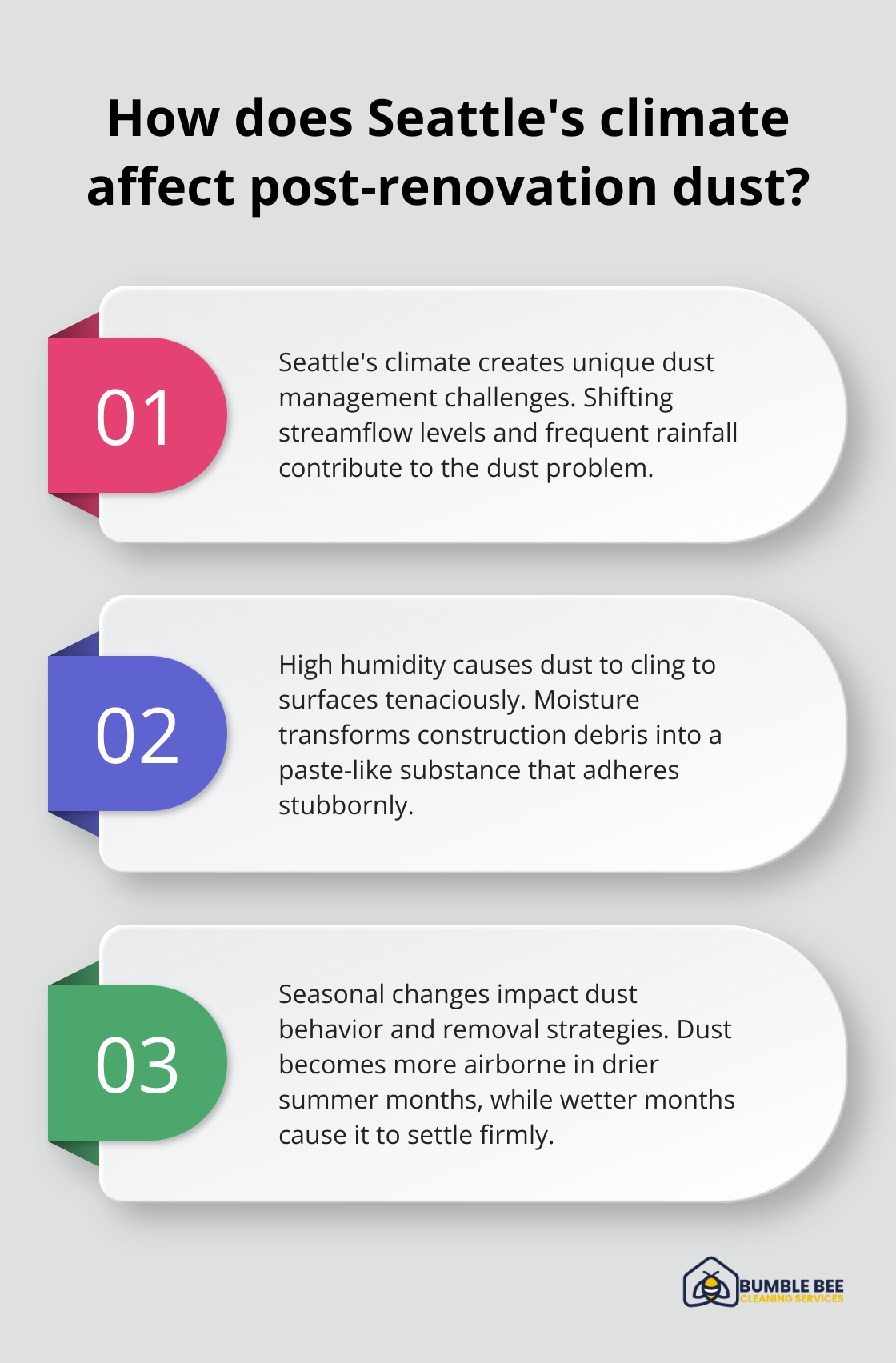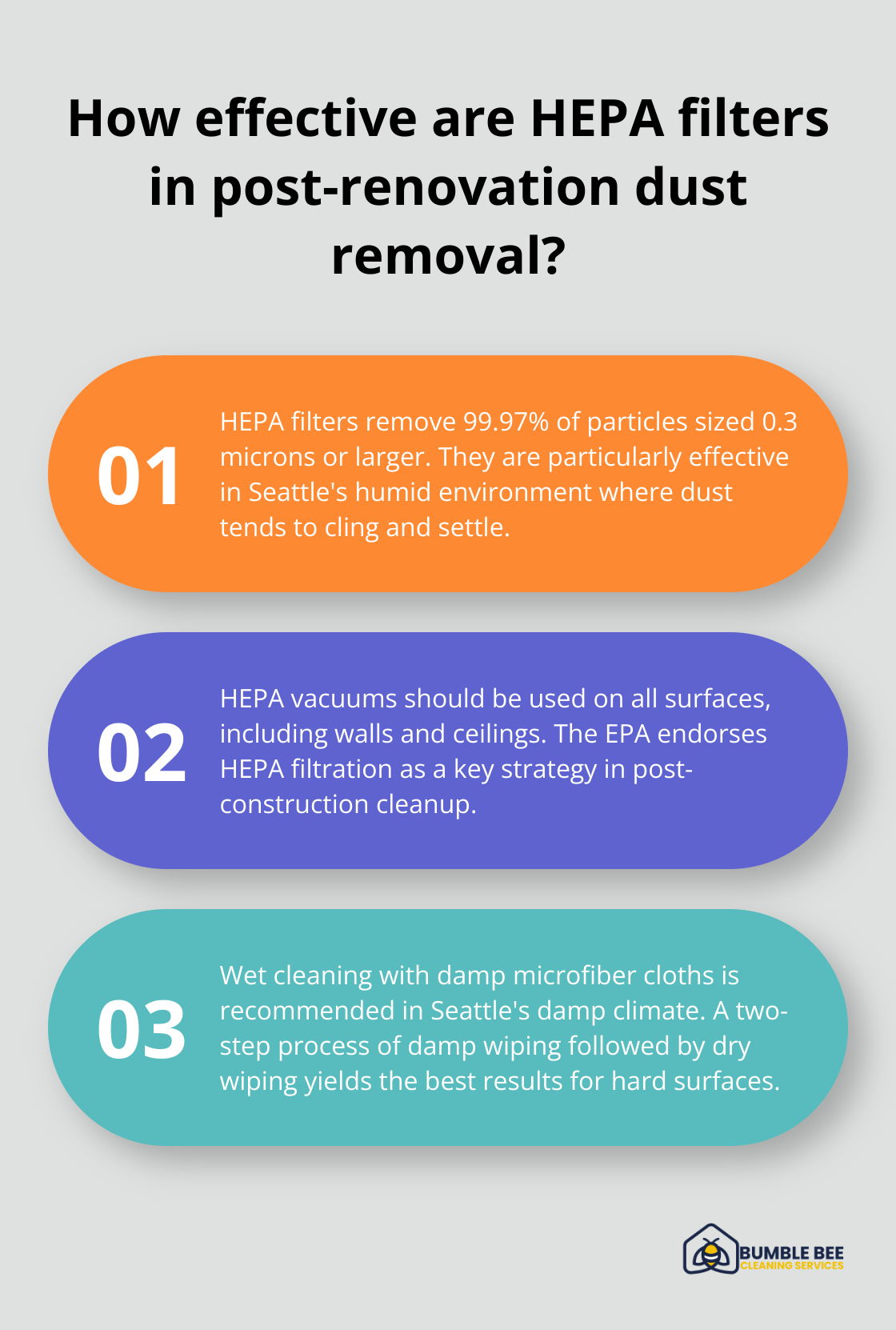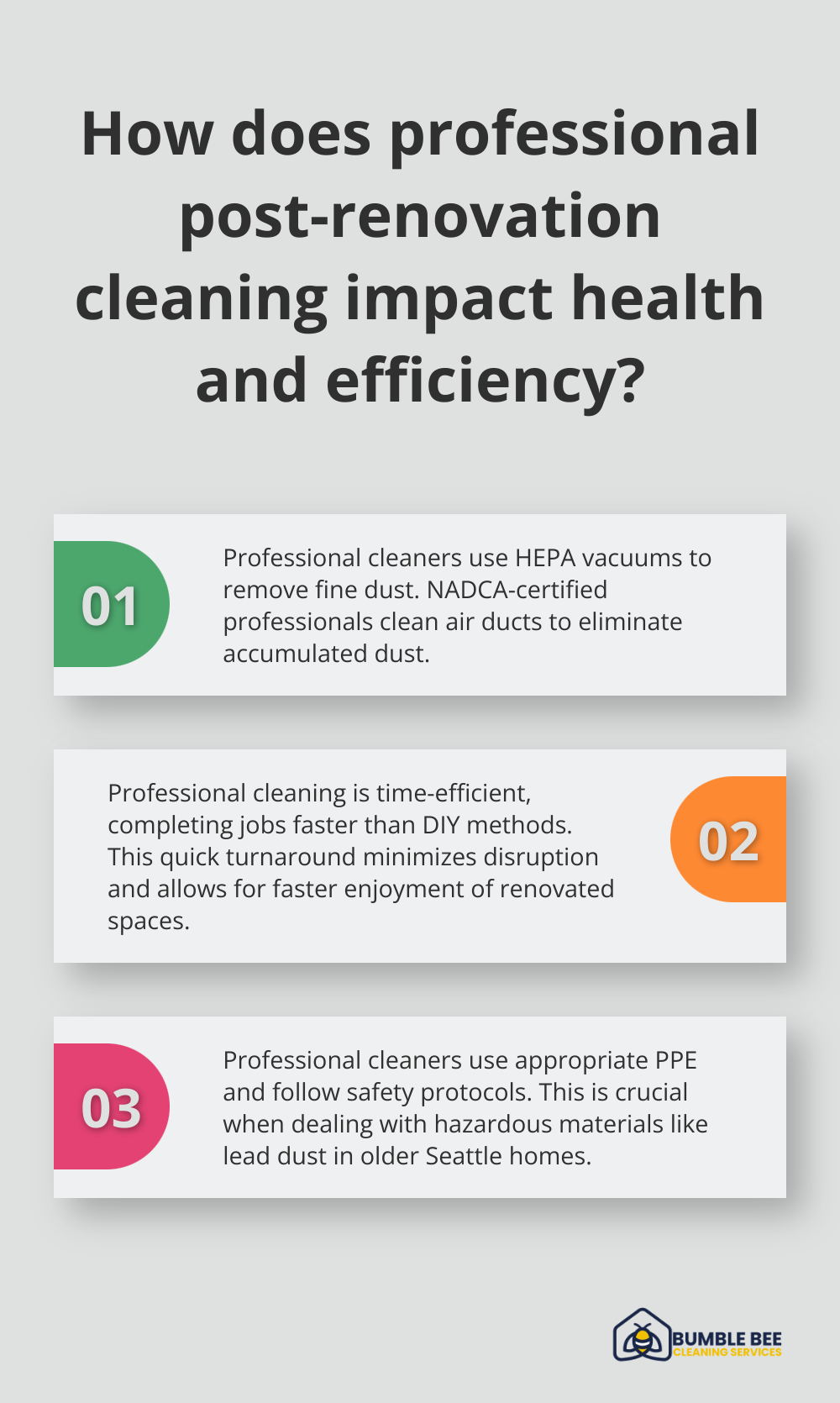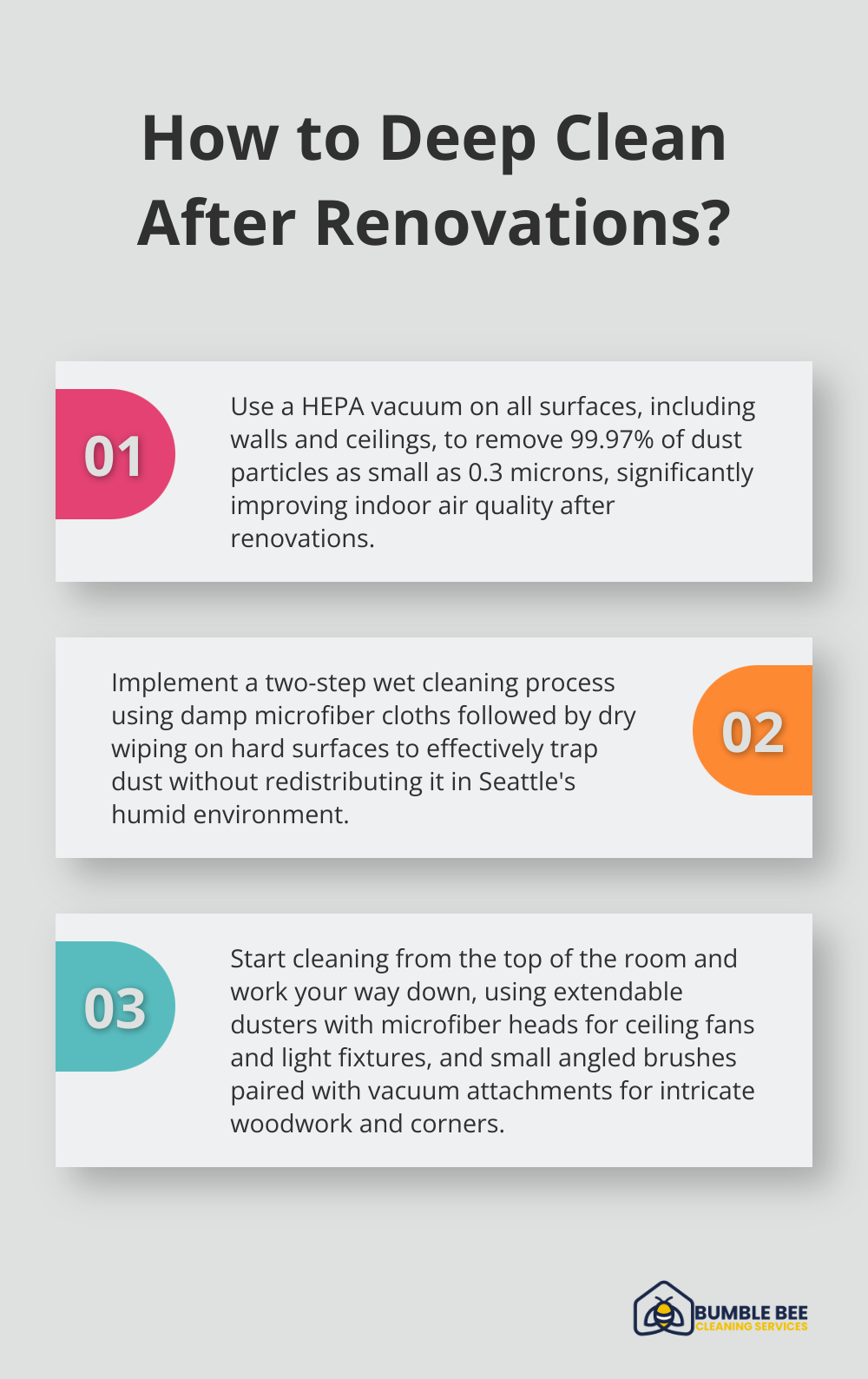Renovations in Seattle bring a unique challenge: persistent dust that lingers long after the work is done. At Bumble Bee Cleaning Services, we understand the frustration of homeowners facing this post-construction cleanup dilemma.
Seattle’s damp climate can exacerbate dust issues, making thorough removal essential for both aesthetics and health. In this guide, we’ll explore effective strategies to tackle renovation dust, ensuring your newly updated space is clean, fresh, and ready to enjoy.
Why Seattle’s Dust Problem Is Unique
The Seattle Climate Factor
Seattle’s unique climate creates a distinct challenge for post-renovation dust management. Shifting streamflow levels as more precipitation falls as rain and snowpack melts earlier contribute to the dust problem. This frequent rainfall, combined with high humidity levels, causes dust particles to cling tenaciously to surfaces. The moisture-rich atmosphere transforms construction debris into a paste-like substance that adheres stubbornly to various materials.
Health Implications of Renovation Dust
The health risks associated with renovation dust in Seattle are substantial. Fine particulate matter from construction activities can worsen respiratory conditions. This is particularly concerning given that asthma rates in King County are a health concern. The Healthcare Effectiveness Data and Information Set measures (“HEDIS®”) provide audited performance rates and associated benchmarks for healthcare in the region. These statistics underscore the importance of thorough post-renovation cleaning to protect residents’ health.
The Necessity of Dust Removal
Inadequate post-renovation cleaning often leads to more intensive treatments later on. This not only increases costs for homeowners but also prolongs exposure to potentially harmful particles. The Environmental Protection Agency (EPA) emphasizes that thorough cleaning after renovations is essential for maintaining indoor air quality and protecting occupant health. Professional cleaning services (like those offered by Bumble Bee Cleaning Services) can effectively address these concerns and ensure a safe living environment.
Hidden Dangers in Neglected Dust
Renovation dust isn’t just a nuisance; it can contain hazardous materials. Older homes in Seattle, particularly those built before 1978, may have lead-based paint. When disturbed during renovations, this can release toxic lead dust. The Seattle & King County Public Health department strongly advises professional cleaning services for post-renovation cleanup in older homes to ensure safe removal of potentially dangerous particles.
The Impact of Seasonal Changes
Seattle’s seasonal changes also affect dust accumulation and removal. During the drier summer months (July and August), dust can become more airborne and spread easily. Conversely, the wetter months (November through January) can cause dust to settle and adhere more firmly to surfaces. These seasonal variations require adaptable cleaning strategies to effectively manage post-renovation dust throughout the year.

As we move forward, it’s important to understand the specific techniques and tools that can effectively combat Seattle’s unique dust challenges. The next section will explore the most effective dust removal techniques tailored to Seattle’s climate and construction practices.
Mastering Post-Renovation Dust Removal in Seattle
Seattle’s unique climate demands specialized techniques for effective post-renovation dust removal. This chapter explores the most effective methods to combat stubborn dust in Seattle homes after construction work.
The Power of HEPA Filtration
HEPA (High-Efficiency Particulate Air) filtration systems play a vital role in post-renovation cleaning. These filters can remove at least 99.97% of dust, pollen, mold, bacteria, and any airborne particles with a size of 0.3 microns. In Seattle’s humid environment, where dust tends to cling and settle, HEPA vacuums prove particularly effective. They remove visible dust and capture microscopic particles that can aggravate respiratory conditions.

For optimal results, use HEPA vacuums on all surfaces, including walls and ceilings. This comprehensive approach eliminates even the finest dust particles, which significantly improves indoor air quality. The EPA endorses HEPA filtration as a key strategy in post-construction cleanup, highlighting its importance in maintaining a healthy living environment.
Wet Cleaning: A Seattle-Specific Approach
Seattle’s damp climate necessitates a wet cleaning approach to prevent dust from becoming airborne during the cleaning process. Damp microfiber cloths excel at trapping dust without redistributing it. For hard surfaces like countertops and floors, a two-step process of damp wiping followed by dry wiping yields the best results.
When cleaning walls, a solution of warm water and a mild, pH-neutral detergent works wonders. This method removes dust and addresses any moisture-related issues that may have arisen during the renovation. Work from top to bottom to prevent cleaned areas from becoming recontaminated.
Tackling Hard-to-Reach Areas
Post-renovation dust often lurks in hard-to-reach areas, which requires specialized tools and techniques. Extendable dusters with microfiber heads excel at cleaning ceiling fans, light fixtures, and crown molding. For intricate woodwork and tight corners, small, angled brushes paired with a vacuum attachment effectively dislodge and remove stubborn dust.
Air duct cleaning is another critical step often overlooked in post-renovation cleanup. The air conditioning system will not produce dust; it can only circulate existing dust. Professional duct cleaning services use specialized equipment to thoroughly remove construction debris from your ventilation system.
The Importance of Systematic Cleaning
A systematic approach to post-renovation cleaning yields the best results. Start with air purification using HEPA air cleaners to capture airborne particles. Next, focus on high surfaces and work your way down. This top-to-bottom method ensures that dislodged dust is captured at each level, which prevents recontamination of cleaned areas.
For particularly challenging projects, consider the use of negative air machines. These industrial-grade air scrubbers create a controlled airflow that prevents dust from spreading to unaffected areas of the home during the cleaning process.
In Seattle’s unique environment, thorough post-renovation dust removal requires a combination of specialized equipment, targeted techniques, and systematic approaches. The next chapter will explore the benefits of professional post-renovation cleaning services and what to look for when choosing a provider.
The Importance of Professional Post-Renovation Cleaning
Expert Knowledge and Equipment
Professional cleaners possess in-depth knowledge of different surface types and the most effective cleaning methods for each. They use industrial-grade equipment that outperforms consumer-level tools. For instance, professional-grade HEPA vacuums remove fine dust that has settled into fibers, effectively eliminating construction dust.
NADCA professionals are certified to clean air ducts, which is crucial after renovations as dust accumulates in these hard-to-reach areas.
Time and Cost Efficiency
While hiring professionals might seem more expensive initially, it often proves cost-effective in the long run. DIY cleaning can take days or even weeks, whereas professional teams complete the job in a fraction of the time. This quick turnaround minimizes disruption to your daily life and allows you to enjoy your newly renovated space sooner.

Moreover, professionals prevent costly mistakes. Improper cleaning techniques can damage surfaces or fail to remove all dust, leading to potential health issues or the need for additional cleaning later.
Health and Safety Considerations
Professional cleaning services prioritize health and safety. They use appropriate personal protective equipment (PPE) and follow strict safety protocols. This is particularly important when dealing with potentially hazardous materials like lead dust in older Seattle homes.
The Washington State Department of Health provides data on blood lead testing and elevated blood lead levels among Washington children. Lead-based paint and lead-contaminated dust are significant concerns. Professional cleaners receive training to handle such situations safely and effectively.
Selecting the Right Cleaning Service
When choosing a post-renovation cleaning service in Seattle, look for companies with specific experience in post-construction cleanup. Check for certifications from organizations like the Institute of Inspection Cleaning and Restoration Certification (IICRC). These certifications indicate a commitment to industry standards and ongoing education.
Bumble Bee Cleaning Services stands out in this regard. With certifications from ARCSI, IICRC, and OMWBE, our team has the equipment to handle the complexities of post-renovation cleaning in Seattle. We use eco-friendly products and offer a 100% quality service guarantee, ensuring that your newly renovated space is not only clean but also safe and healthy for occupancy.
The Value of Specialized Equipment
Professional cleaning services invest in specialized equipment designed for post-renovation cleanup. This includes industrial-strength vacuums (with HEPA filtration), high-powered air scrubbers, and advanced cleaning solutions. These tools remove even the finest particles of dust and debris, which standard household cleaning equipment often misses.
For example, professional-grade air scrubbers can filter out particles as small as 0.3 microns (about 1/100th the width of a human hair). This level of filtration significantly improves indoor air quality after renovations, which is particularly important in Seattle’s climate where dust can linger due to high humidity.
Final Thoughts
Post-renovation dust in Seattle presents unique challenges due to the city’s climate and environmental factors. Effective dust removal requires specialized techniques, advanced equipment, and expert knowledge. HEPA filtration systems, wet cleaning methods, and systematic approaches tackle stubborn dust particles that cling to surfaces in Seattle’s damp environment.

Professional post-construction cleanup offers significant advantages over DIY methods. Experts bring specialized equipment and efficient processes that save time and ensure comprehensive dust removal. In Seattle’s unique climate, where dust can persist, professional services often provide the most effective solution.
Bumble Bee Cleaning Services offers comprehensive cleaning solutions tailored to Seattle’s specific needs. Our team uses eco-friendly products and provides a 100% quality service guarantee (subject to terms and conditions). For expert post-construction cleanup in Seattle, visit Bumble Bee Cleaning Services to learn more about our services.
